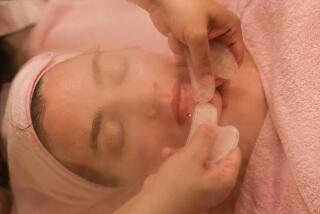Bad news in Gaza, Iraq and D.C., but good news in Botox business
The awfulness of Gaza goes on. So does the madness in Iraq and Syria. Wildfires burn through the West, while in Washington, our do-absolutely-nothing Congress prepares to adjourn, freeing up time for representatives and senators to go home and campaign to be reelected so they can accomplish nothing for another two years.
It seems an opportune time to consider a far less depressing issue, one that, outside of Hollywood and the Redneck Riviera, affects only a small minority: artificial body enhancement, a.k.a., cosmetic surgery or âhaving a little work done.â
I am mostly vacationing this week (hence my desire to avoid the big issues). My days are being spent on the shores of a gorgeous lake. Temperatures are hitting 100 degrees and, all around me, people are cavorting in swimsuits that reveal just how diverse human bodies can be.
Really, Homo sapiens is an unusual species. Other creatures of the same type pretty much all look alike. Sure, there are subtle differences, but it really is not a simple thing to tell one wolf from another. Or differentiate goldfish or ducks or chimpanzees. But humans? We can be 6-foot-5 beanpoles or 5-foot-6, square-shouldered, barrel-chested fire hydrants. Some are as lithe and leggy as dancers, others as bulbous as hippos.
Because we do not all look alike, humans, individually and collectively, have developed the concept of beauty and its opposite, ugly. In every age and in every society, certain types of bodies and faces have been preferred over others. Pacific Islanders used to believe bigger was better. Rubens also clearly favored females of great heft. Todayâs anorexic beauties would have been considered freaks in old Tahiti or obvious members of the destitute underclass during the Renaissance.
Fat or thin, at various times in various cultures, womenâs bodies have been altered to conform to the prevailing concept of beauty. Female feet have been bound, female necks have been stretched by metal rings, female torsos have been corseted. Today, most of these methods would be considered cruel and crazy.
We are so much more enlightened now, right? Heck, it makes perfect sense for a woman to have a surgeon implant globs of plastic-wrapped fluid in her chest so her breasts are the size of basketballs. And what could be misguided about injecting junk into your lips so they appear to have been stung by bees? And, gosh, who wouldnât want to have needles poked into your face to squirt in some sort of super glue that smoothes out wrinkles and pins your mouth into a permanently weird grin?
Weâve all seen the celebrities who have taken these procedures way too far -- their eyes and cheeks and lips and mouths stretched and warped until their appearance is permanently altered. Weâve seen Pamela Anderson go from perky boobs to watermelons and back. And we watched Michael Jackson transform from a cute black kid with a nice round nose to a pale-skinned elf with hardly any nose at all.
Itâs not just celebrities, of course, who do these things to themselves, it is also people who try to emulate celebrities and end up looking as plastic as Barbie dolls.
In Hollywood, there has been a backlash against all this nipping and tucking and ballooning to double-Ds. Even Kim Kardashian has sworn off Botox. Reportedly, the number of cosmetic surgical procedures in the U.S. has dropped significantly since 2008. That shows that common sense can occasionally get the upper hand.
This doesnât mean that women with tinier noses and bigger breasts still donât get more attention, just as guys with perfect six packs are ogled more than lads with beer guts. But maybe a few more people are learning to be happy with the bodies they were born with and finding healthier ways to enhance what they have.
So, here at the cusp of summer, letâs all aspire to enhance, by natural means, whatever small measure of beauty we have been granted. Personally, I pledge to do a few crunches and push-ups before I go down to the dock to swig Coronas and dive into the chips.
More to Read
A cure for the common opinion
Get thought-provoking perspectives with our weekly newsletter.
You may occasionally receive promotional content from the Los Angeles Times.











